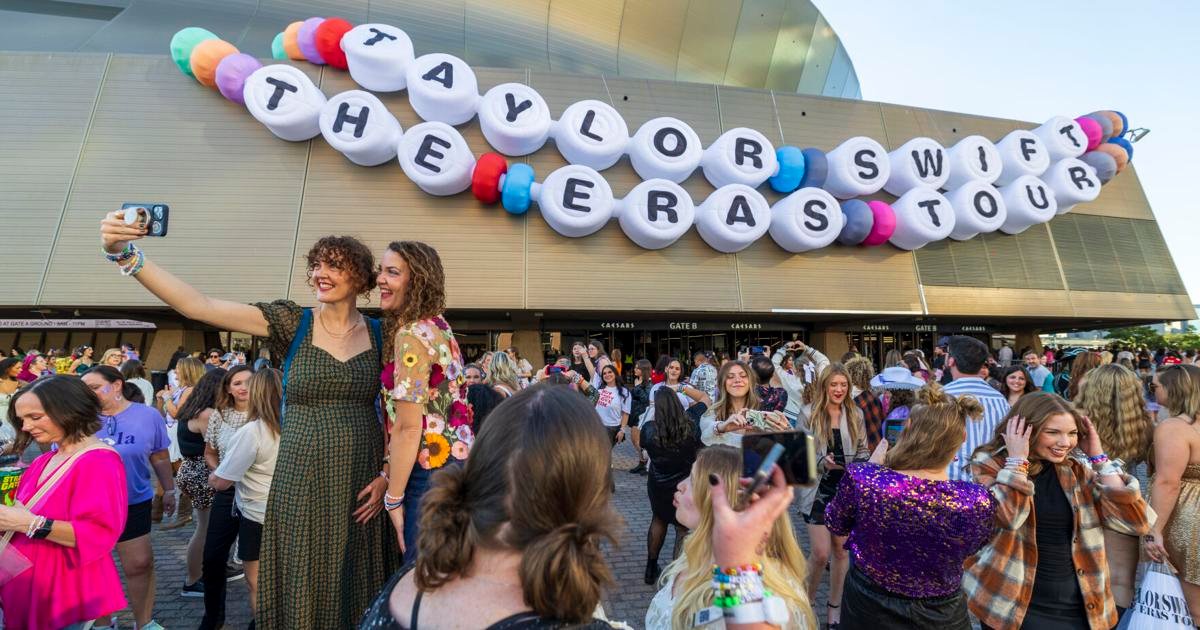New Orleans played host to more than 19 million visitors in 2024, a near-record number that tourism officials say signals a recovery from four sluggish years following the coronavirus pandemic.
According to a study conducted by hospitality firm MMGY Global, the nearly 19.1 million visitors that came New Orleans last year represented a 6.4% increase over the year before and only the second time on record that the city has attracted more than 19 million visitors.
The other time was in 2019, when the city’s visitor count topped 19.7 million.
“This is a real high point for us,” said Walt Leger, III, president and CEO of New Orleans & Co., which commissioned the recent study. “When you think about where we were five years ago, it certainly signals an improvement and success, so we are happy.”
The study results are significant in a city where the tourism and hospitality sector is a major driver of the local economy. Visitors to the city last year spent more than $10.4 billion – more than twice as much as two decades ago – not counting billions more in occupancy and sales taxes.

Crowds walk Royal Street during Mardi Gras in New Orleans, Tuesday, March 4, 2025. (Photo by Sophia Germer, The Times-Picayune)
Additionally, more than 80,000 people in the New Orleans area work for hotels, restaurants and tourist attractions, according to New Orleans & Co.
But while the industry is trumpeting the recent study results, it is also bracing for a slow summer season with potentially more headwinds in the fall and beyond. The Trump administration’s tariffs, concerns about inflation, and shifting global alliances are taking a noticeable bite out of the travel industry nationally and locally, experts say.
Foreign travelers in particular have cut back plans for corporate, group and individual travel, and New Orleans is already feeling the effects, Leger said.
“International travel has been impacted somewhat, though not significantly, especially from our Canadian friends,” he said. “We are hopeful in the long term there won’t be any damage but in the immediacy, there is.”
Banner year
The MMGY study, compiled from online surveys of visitors and several other metrics, found that the city’s visitor count has been gradually recovering since the pandemic – from 15.7 million in 2021 to 17.5 million in 2022, 17.9 million in 2023 and 19.08 million in 2024.
Those numbers roughly mirror the three years prior to the pandemic, when the city was seeing significant year-over-year growth in its hospitality sector. In 2017, the city attracted 17.7 million visitors. In 2018, 18.5 million; and, in 2019, 19.75 million.
In the post-Katrina decade, visitor counts slowly grew from less than 4 million in 2006 to nearly 10 million in 2015. The first time the city broke the 10-million mark was in 2016.
Last year was a particularly banner year, officials have said, because of a series of all-star attractions. In the spring, a Rolling Stones appearance added an extra day to the Jazz Fest calendar. In the fall, Taylor Swift’s Eras tour brought some 200,000 fans to the city for three back-to-back performances.
The city also had a robust festival season and busier than usual Essence Fest in July.

Angie Balliviero poses in a Jazz Fest hat in the crowd waiting for Pearl Jam during the seventh day of the New Orleans Jazz & Heritage Festival at the Fair Grounds in New Orleans, Saturday, May 3, 2025. (Photo by Sophia Germer, The Times-Picayune)
As a result, visitor spending was up last year to $10.4 billion, nearly approaching 2019’s record $10.5 billion spend, though inflation was also slightly higher last year – nearly 3% – which could partially account for the increased dollar figure.
“Obviously we are happy people spent more money, but costs are higher,” Leger said. “So, I think any spending analysis has to take into account the overall economic environment.”
Doubling down
Visitor numbers and spending are just some of the ways of measuring the health of the city’s tourist economy. Hotel occupancy rates and revenues, convention bookings and customer satisfaction are others. So is the city’s ability to balance the needs of its tourism industry with the needs of local businesses and residents.
Several local hotel, restaurant and tour operators say the MMGY study affirms what they noticed within their own businesses last year. Activity and spending were up. More visitors were on the street. Even the normally slow summer was livelier than usual.

Hotel Royal on Royal Street in the French Quarter, part of the J Collection of hotels.
Hotelier Zach Kupperman said occupancy rates at Hotel St. Vincent in the Garden District were up 7% in 2024, while revenues also were higher.
Emily Valentino, whose family owns six hotels in the French Quarter and downtown as well as Hop On Hop Off Bus Tours, said last year “felt like we had turned a corner.”
Jayson Seidman’s bar and restaurant on Jackson Square, Fives Bar, did so well last year that he is expanding into a vacant space next door. The new dining room, which he hopes to be completed by the spring, will enable him to serve more than twice as many customers.
“I guess you could say we’re doubling down on New Orleans,” Seidman said, whose Sandstone Hospitality owns and operates several hotels and restaurants.
Hospitality experts point to other trends that signal investors’ faith in the city’s visitor economy. Last week, New York-based Certeras Management, a real estate investment firm, paid $47 million for the Hilton New Orleans Hotel, located in a century-old building in the Central Business District.
“This is a good time to buy a hotel in New Orleans,” said Len Wormser, senior vice president for Hospitality Real Estate Counselors, a hotel property brokerage. “There are reasonable values, a limited new supply of hotel rooms and a stacked convention calendar for next year.”
Headwinds
The recent MMGY study was released Friday, two weeks into the official summer season, which is always slow. Some business owners are feeing the heat more than others.
After a strong 2024, Valentino said the first six months of 2025 have been disappointing, with no relief in sight for the short term. The Super Bowl, Mardi Gras and French Quarter Fest, which brough visitors to hotels, didn’t necessarily help businesses like her bus tour company.
“Events, festivals or concerts are a distraction for local businesses,” Valentino said. “Leisure travelers come to explore the city. We hope to see more of them in the future.”
Seidman, on the other hand, said bookings at his hotels, including the Columns Hotel and The Henrietta, have been strong for the first half of 2025, though “we’re getting ready to fall off into this deep dark hole of summer.”

New Orleans & Co., as well as local merchants, have been more strategic in recent years about creating seasonal events in the summer to help tourist-related businesses through the slow times.
“We are hyper focused on trying to drive business in the summer,” Leger said. “And we’re always trying to do more.”
One concern, he said, is the effect that the Trump administration’s policies on trade and immigration are having on international travel, both locally and nationwide. Some international travelers can’t get travel visas. Others no longer want to come to the U.S., according to Leger.

Activity from Canadian travelers in particular has been affected, he said. The country, because of its shared history with Louisiana, traditionally makes up the largest group of foreign visitors to the city.
“We are speaking with our customers and they are expressing their love of our city and state,” Leger said. “But out of a commitment to their own nation, they don’t want to travel here right now.”
https://bloximages.newyork1.vip.townnews.com/nola.com/content/tncms/assets/v3/editorial/5/f9/5f96c7ed-f7fe-50b9-a9bc-3b4098d4bbc9/671c65fadfb02.image.jpg?crop=1763%2C926%2C0%2C125&resize=1200%2C630&order=crop%2Cresize
2025-06-15 09:00:00

